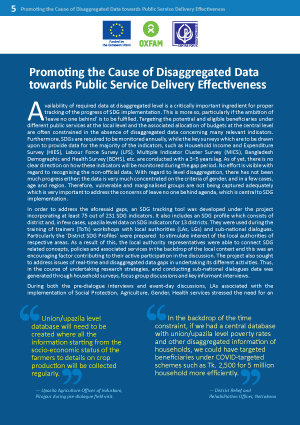 Availability of required data at disaggregated level is a critically important ingredient for proper tracking of the progress A of SDG implementation. This is more so, particularly if the ambition of ‘leave no one behind’ is to be fulfilled. Targeting the potential and eligible beneficiaries under different public services at the local level and the associated allocation of budgets at the central level are often constrained in the absence of disaggregated data concerning many relevant indicators. Furthermore, SDGs are required to be monitored annually, while the key surveys which are to be drawn upon to provide data for the majority of the indicators, such as Household Income and Expenditure Survey (HIES), Labour Force Survey (LFS), Multiple Indicator Cluster Survey (MICS), Bangladesh Demographic and Health Survey (BDHS), etc. are conducted with a 3–5 years lag. As of yet, there is no clear direction on how these indicators will be monitored during the gap period. No effort is visible with regard to recognising the non-official data. With regard to level disaggregation, there has not been much progress either; the data is very much concentrated on the criteria of gender, and in a few cases, age and region. Therefore, vulnerable and marginalised groups are not being captured adequately which is very important to address the concerns of leave no one behind agenda, which is central to SDG implementation.
Availability of required data at disaggregated level is a critically important ingredient for proper tracking of the progress A of SDG implementation. This is more so, particularly if the ambition of ‘leave no one behind’ is to be fulfilled. Targeting the potential and eligible beneficiaries under different public services at the local level and the associated allocation of budgets at the central level are often constrained in the absence of disaggregated data concerning many relevant indicators. Furthermore, SDGs are required to be monitored annually, while the key surveys which are to be drawn upon to provide data for the majority of the indicators, such as Household Income and Expenditure Survey (HIES), Labour Force Survey (LFS), Multiple Indicator Cluster Survey (MICS), Bangladesh Demographic and Health Survey (BDHS), etc. are conducted with a 3–5 years lag. As of yet, there is no clear direction on how these indicators will be monitored during the gap period. No effort is visible with regard to recognising the non-official data. With regard to level disaggregation, there has not been much progress either; the data is very much concentrated on the criteria of gender, and in a few cases, age and region. Therefore, vulnerable and marginalised groups are not being captured adequately which is very important to address the concerns of leave no one behind agenda, which is central to SDG implementation.

